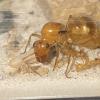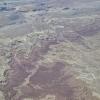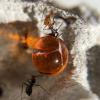Scientific Name: Veromessor pergandei (previously Messor pergandei in older literature)
Common Name: Black Harvester ant, Desert Harvester ant
Distribution: Primarily desert regions of North America, such as in southern California, Nevada, Arizona, and Mexico. Does not usually extend into Utah or New Mexico. “Mohave desert, Sonoran desert, Baja California desert, Gulf of California xeric scrub, and California coastal sage and chaparral ecoregions” (Johnson et al., 2022; via AntWiki)
Queen size: 10 mm.
Worker size: Polymorphic, 4-8 mm.
Natural Habitat: Desert
Circadian Activity: Diurnal in winter; crepuscular (dawn/dusk foraging) in summer.
Mating Flight: February, March, April. Dependent on photoperiod, not rainfall. Theory is that V. pergandei queens cannot tolerate hot summer temperatures, so they must fly in the cooler months.
Queen Founding Method: Fully claustral, but it doesn’t hurt to provide some seeds or protein to founding queens. Their relatives V. andrei are semi-claustral.
Monogyne or Polygyne: Can be monogyne (only one queen), pleo (delayed monogyne), or polygyne (multiple queens). This varies by location. Primarily polygynous V. pergandei apparently tend to occur at the border between California, Nevada, and Arizona. Other California V. pergandei tend to be monogyne, and those deeper in Arizona are pleo.
Average time from egg to worker: -
Recommended Temperature: Summer temperature: 85-89 F (29.4 C – 32 C). Temps lower than roughly 85 F the queen may not lay eggs. Do not set temps too high; queens do not have extreme heat tolerance and are known to die at 107 F (42C). Provide a heat gradient. Winter temperature: roughly 70 (21.1 C) is fine.
Recommended Humidity: Provide humidity gradient. V. pergandei like humid areas of their nest for putting their larvae, but prefer to store seeds in dry sections.
Preferred Foods: Seeds: dandelion, poppy, amaranth, quinoa, Kentucky blue grass, other seeds – choose organic where possible. They can get excited about sunflower seeds but may not be able to open them. Insects: fruit flies, crickets, roaches, mealworms, etc. They do not need sugar water. Supposedly they do not have a social stomach.
Hibernation Details: Active all year, but let the queen rest from egg-laying over the winter. Room temperature (e.g. 70 F/21 C) is fine. Provide at least three months’ of rest, with occasional seed (not as necessary if they have seed stockpiled). Always provide fresh water. As winter ends, gradually increase temps, gradually start offering new seed, once a week offer small amounts of insect protein (not mandatory, but beneficial in small quantities), and by late spring or early summer allow them to have full summer temperature. This will allow them to begin producing brood. This is also when their water will evaporate the fastest and the ants will be the thirstiest, so check the water frequently. If you are delayed in providing heat (e.g., one year I didn’t raise the temperature high enough until late summer), at least give them heat long enough for them to raise up a new generation of workers to replenish those that will soon die of old age. In fall, gradually lower temperatures and reduce food, always making sure to keep the fresh water supply available.
Escape Barrier Methods: Fluon, or food-grade mineral oil (very thinly applied to the outworld, but may still kill some workers; do not use mineral oil with founding colonies with only a few workers)
Difficulty rating: Easy.
Bite and/or Sting rating: No sting; harmless bite.
Special Care or Interesting Notes: V. pergandei is a terrific beginner ant, easy to keep, not dangerous, active all year, polymorphic (eventually), and easy to feed because they do not depend on frequent insect protein (though they do benefit from it). They also do not need sugar water! They DO need water, all the time. Read through the notes on the temperature changes from winter to summer and back. Unlike many ants, they do not need to go into a wine fridge and can be observed in the winter. But they do want something of a vacation from baby making. V. pergandei have something of a reputation for being boring, but they can be exciting in some regards. Yes, they grow larger workers (sometimes called majors). And they also grow lots of workers. For example, they can theoretically exceed 50,000 workers, they can theoretically produce upwards of 650 new workers per DAY, and they like to forage in large columns. This means that feeding time can trigger a mass foraging column, and the phototropic ants will try to march en masse toward the nearest light source and escape from the outworld. Their style of foraging also means they are not the favorite prey of the desert horned lizard, since the lizard is likely to get mobbed by angry ants. Speaking of angry ants, V. pergandei has been observed to dismantle spider webs to rescue nestmates, an apparently unusual behavior among ants. (However, it should be noted that only the largest workers do this sort of rescue behavior.) You are NOT obligated to provide so much food they produce 650 new workers a day, but you do need to provide enough food they replenish the workers that die of old age. Individuals have been observed to chew persistently on nest walls, so suggest avoiding softer nest materials and sticking with hard materials. Speaking of escape, V. pergandei are fairly small ants, and are able to slip through cracks easily. They are, thankfully, larger than Tetramorium, and a healthy, established colony should be producing a good number of larger workers.
Additional Links:
https://www.antwiki....essor_pergandei
http://treatment.pla...7/1/271/1744921 (Mono, pleo, or poly discussion)
Information submitted by OhNoNotAgain
- Formiculture.com
- Forums
- Gallery
- Members
- Member Map
- Chat




















